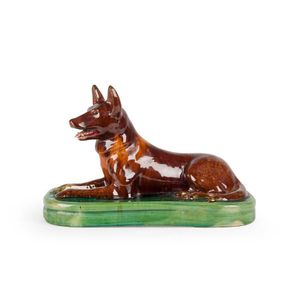Victorian Walnut Canterbury with Ornate Pierced Details
A Victorian walnut canterbury, top shelf with pierced gallery, the base with one drawer and three compartments for music, highly ornate pierced sides and galleries, raised on turned feet with china casters. 58 cm x 38 cm x 91 cm.
You must be a subscriber, and be logged in to view price and dealer details.
Subscribe Now to view actual auction price for this item
When you subscribe, you have the option of setting the currency in which to display prices to $Au, $US, $NZ or Stg.
This item has been sold, and the description, image and price are for reference purposes only.
- Pierced Decoration - Ornamental woodwork with part of the background cut through and removed to produce an open-work pattern.
- Turning - Any part of a piece of furniture that has been turned and shaped with chisels on a lathe. Turned sections include legs, columns, feet, finials, pedestals, stretchers, spindles etc. There have been many varieties and fashions over the centuries: baluster, melon, barley-sugar, bobbin, cotton-reel, rope-twist, and so on. Split turning implies a turned section that has been cut in half lengthwise and applied to a cabinet front as a false decorative support.
- Gallery - On furniture, a gallery is a small upright section, frequently pierced and decorated, around the tops of small items of furniture, such as davenports, side tables, and so forth. Galleries are made in brass or bronze,and be fretted, pierced or solid timber. A three-quarter gallery is one that surrounds three of the four sides of a table, desk or other top.
- Victorian Period - The Victorian period of furniture and decorative arts design covers the reign of Queen Victoria from 1837 to 1901. There was not one dominant style of furniture in the Victorian period. Designers used and modified many historical styles such as Gothic, Tudor, Elizabethan, English Rococo, Neoclassical and others, although use of some styles, such as English Rococo and Gothic tended to dominate the furniture manufacture of the period.
The Victorian period was preceded by the Regency and William IV periods, and followed by the Edwardian period, named for Edward VII (1841 ? 1910) who was King of the United Kingdom and the British Dominions and Emperor of India for the brief period from 1901 until his death in 1910.
This item has been included into following indexes:
Visually similar items

A Chinese carved jadeite serpent pendant with silver mount, length 9 cm
Sold by
in
for
You can display prices in $Au, $US, $NZ or Stg.

Superb Sheraton style desk, with rounded back and extensive inlay, 144 cm high, 60 cm deep, 101 cm high
Sold by
in
for
You can display prices in $Au, $US, $NZ or Stg.

McHugh Tasmanian pottery 'Kelpie' dog doorstop glazed in green & brown. Height 21 cm, width 33 cm, depth 15 cm
Sold by
in
for
You can display prices in $Au, $US, $NZ or Stg.

Campbell monkey face jug, 11.5 cm high. 1935, green
Sold by
in
for
You can display prices in $Au, $US, $NZ or Stg.
